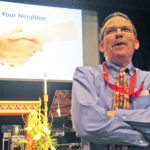By Patrick Schmadeke
Evangelization in the world today
Near the end of the movie “Thor: Ragnarok,” the villain Hela has done the unimaginable: she has overtaken Asgard — a shining golden city, the home of the gods. As the defenders of Asgard are

overwhelmed by her power, a nearly defeated Thor, the god of thunder, speaks with his father in a vision. Odin responds: “Asgard is not a place. Never was … Asgard is where our people stand.” A short while later, with residents evacuated to a space ship, Asgard is destroyed in what resembles the explosion of a star. After seeing the destruction, Heimdall, a friend and advisor to Thor, remarks, “Asgard is not a place. It’s a people.”
If the mythic comic world can answer the question “What is Asgard?,” we can ask, “What is the Church?” We have many metaphors and images to describe the Church. Here’s a sample from Vatican II: bride of Christ, sheepfold, flock, God’s farm or field, God’s building, the spotless spouse of the spotless lamb, mystical body of Christ. The Church is described as human and divine. It is “at once holy and in need of purification.”
In his “Models of the Church,” Cardinal Avery Dulles provides six different models, or ways, to come to a better understanding of the Church. The six models are the Church as institution, mystical communion, sacrament, herald, servant and community of disciples. Each model casts a unique light on the Church, illuminating dimensions of the Church that other models miss. Each of the above metaphors, images or models has something to offer. Here, I’d like to unpack the Church as the people of God.
In the second draft of the document on the Church from Vatican II, the chapter on the hierarchy came before a chapter on the people of God and laity. In the end, this order was modified. In the resulting constitution, “Lumen Gentium,” chapter two is on the people of God, chapter three is on the hierarchy and chapter four is on the laity. This critical turn is rooted in baptism. Through baptism, all people share in an equal dignity as the people of God. The emphasis is placed on the Church as communion, rather than the Church as an institution or a hierarchy.
Lately, when I hear the world “Church” in conversation, I’ve been substituting it with “people of God” in my head. This practice has brought into clearer focus the communal nature of the Church. The Church is always a people, a community, a group, a collection of folks who come together. This has made more real the words of Jesus: “where two or three gather in my name, there I am in their midst” (Matthew 18:20).
This practice also encourages a wider sense of who is part of the community. “All the baptized” includes a wider scope than regularly practicing Catholics with whom we gather on Sunday: my baptized atheist friend from high school, my baptized nondenominational Christian friend, and the list goes on. The chapter on the people of God does not stop with the baptized: “those who have not yet accepted the Gospel are related to the people of God in various ways.” It then mentions Jewish and Muslim people, but goes further, “nor is God remote from those who in shadows and images seek the unknown God, since he gives to everyone life and breath and all things and since the Saviour wills everyone to be saved. Those who … seek God with a sincere heart, and, moved by grace, try in their actions to do his will … these too may attain eternal salvation.”
Lately, the people of God have been on a synodal journey. This has been a matter of listening to one another’s experience of the Church, coming together in deeper communion, discovering fuller participation in the Church and discerning how the Holy Spirit is calling us beyond the four walls of our buildings in our own time. In our own diocese, through the synod, the need to focus on welcoming and belonging in our faith communities has been unmistakable. This need has arisen from the people of God. The issue is then returned to the people of God to address it. The chancery will provide help along the way as we all look in the mirror, asking the Spirit to shape us into the kinds of people and communities where the friendship of God is realized.
(Patrick Schmadeke is Director of Evangelization for the Diocese of Davenport.)











